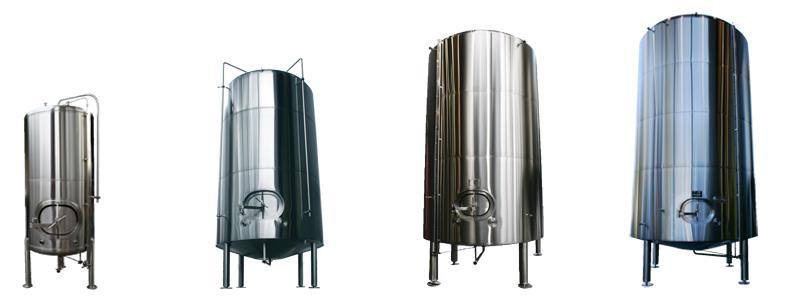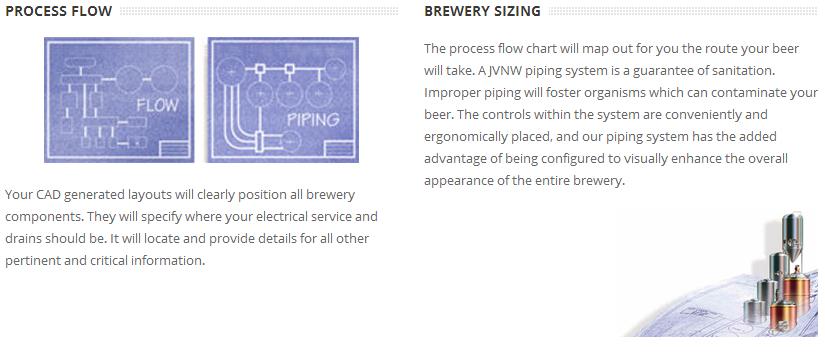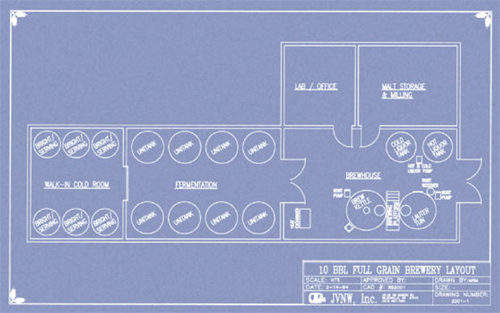BEER TANKS AND CRAFT BREWING SYSTEMS
JVNW, Inc. is an original partner in the pioneering efforts to revive craft brewing in this country. Established in 1981 to supply tanks and equipment to all beverage producers, JVNW began building brewing vessels in a scale to fit the requirements of the small brewer. JVNW manufactured the very first brewing equipment for the early craft breweries in Oregon, Washington and California. We have supplied equipment to over 600 breweries worldwide.

30 BBL 4-Vessel Brewhouse
JVNW is an equipment manufacturing company which recognizes the specific needs of the microbrewery segment of the brewing industry. Our products range from individual pieces of equipment to complete turn-key systems. We can simplify for you, the complexities of the overall brewing process. Our services include brewery sizing, equipment layout, professional installation, system testing, technical assistance, and follow-up support. Each step of the brewing process has many options. Our vessels can be designed with versatility, allowing for the brewery functions to be combined in fewer vessels for economy, or separated into several vessels for increased capacity. A full line of spare parts and accessories are in stock at all times for your convenience. The on-line parts store can be found by clicking on the “Order Parts” button on the top of this page.

LAGER OR ALE?
It is a common misconception that all ale is dark and bitter, while lagers are pale and mild. To the contrary, it is possible to brew a pale, light bodied ale, or a rich, bitter black lager. A full range of flavor and color can be brewed within each style. Although ales do tend to be more fruity and assertive while lagers are typically crisp and mellow, the greatest difference between the two beers is their production method. Ales can be produced in ten to fourteen days, while lagers require three to five weeks. Obviously the capital required for a lager brewery will be greater, as two to three times as many cellar vessels are required to produce the same amount of beer. Longer aging, yeast strain, and lower fermentation temperatures contribute to the clean crisp flavor of lagers while shorter high temperature fermentation of the ale produce the fruity more assertive brew. Some areas of the country are more accustomed to the crisp Germanic lager style, while other regions may prefer the English style ale.

JVNW DOCUMENTATION PACKAGE
The JVNW Brewery Installation Manual will be indispensable to you. The manual is in a handy binder and is indexed for easy reference. It will include very detailed instructions as well as general comments and suggestions. Each section will be directed to either a sub-contractor or dedicated to a piece of equipment. All of your tank specifications and sketches will be included in this book. Your manuals concerning burners, controllers, pumps, and milling machinery will be indexed and organized for you. The descriptions of the chiller and the filter as well as the heat exchanger will be detailed and clear. It will cover carbonation and pressure/vacuum concerns. Your sight glasses, hoses, and fittings will be included. All the specs are in one book making it easy to get your brewery rolling and on its way to making great beer.

BREWERY PERFORMANCE PARAMETER & SAMPLE LAYOUT
MANPOWER REQUIREMENTS
.5 – 1.5 workers/1000 bbls yearly capacity, Average .75 workers/1000 bbls
UTILITIES
Electrical 20 – 35 kWh/bbl
Natural Gas 2 – 3.7 Thermos/bbl
Water 6 – 8 BBL’s water/bbl beer produced
Refrigeration 10 – 20 BTU chiller capacity/bbl yearly capacity
Direct Fired Brew Kettle 25,000 30,000 BTU/bbl Cast Wort
BREWHOUSE YIELD
Single Temperature Infusion 50 – 68%
Temperature Programmed Mash 65 – 72%
SPACE REQUIREMENTS
Complete Brewery .5 – 1 sq. ft./bbl of yearly capacity
Sacked Malt Storage .15 – .25 sq. ft./bbl of yearly capacity

and consumption for your area from government agencies.
Visit JVNW manufacturing facility.
Construct business plan.
Secure primary and fall back financing.
Narrow down site selections.
Contact JVNW for an initial brewery design and equipment placement (layout) and detailed costs.
Discuss plans with local planning commission.
Interview prospective brewers or contact JVNW for instruction services or recommended brewing schools.
Submit label for approval (if bottling).
Contract graphic illustrator for design work.
Visit JVNW for equipment inspection prior to delivery (if possible).
Subscribe to craft brewing trade publications.
Look into purchasing a brewery start-up guide or planner.
Conduct taste testing studies.
Research state, federal, and city regulations and ordinances.
Establish the brewery’s initial and final size.
Plan to attend national conference and pre-conference pub tour.
Don’t forget this is fun!
Research application procedures for appropriate licenses.
Select an architect if needed.
Order equipment and send deposit to secure approximate delivery and installation scheduling.
Review advertising needs (neon signs, t-shirts, tent cards, etc.).
Finalize with JVNW, the final brewery layout and process flow.
Meet with local alcohol abuse agency representatives.
Finalize brewery installation date.
Time to relax have a brew!
Interface with local media to cover delivery of brewing equipment.
Installation, equipment testing and water brew.
Conduct preliminary grand opening as training exercise.
JVNW BREWING SEGMENT @ 17TH MINUTE!




